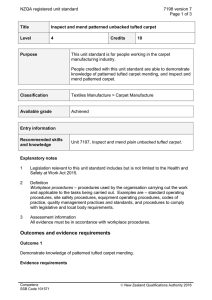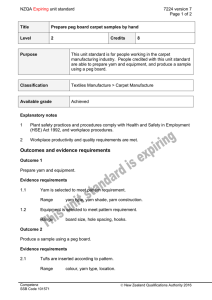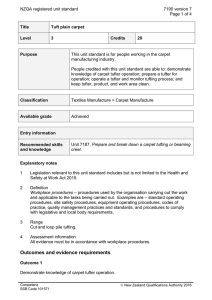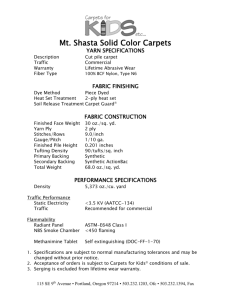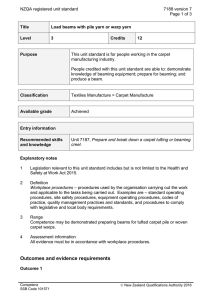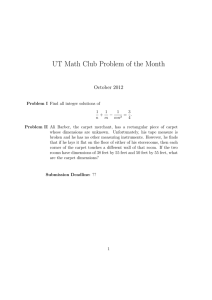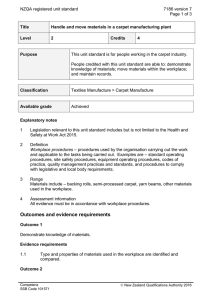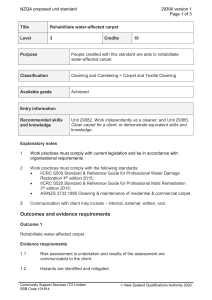NZQA registered unit standard 7197 version 7 Page 1 of 3
advertisement
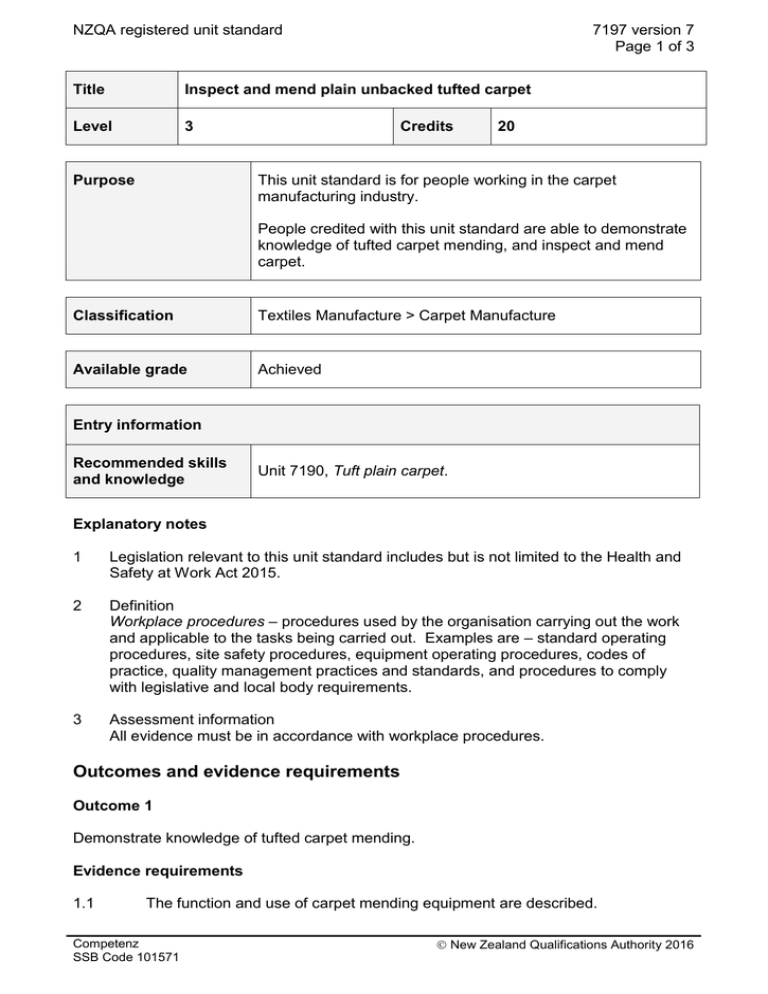
NZQA registered unit standard 7197 version 7 Page 1 of 3 Title Inspect and mend plain unbacked tufted carpet Level 3 Purpose Credits 20 This unit standard is for people working in the carpet manufacturing industry. People credited with this unit standard are able to demonstrate knowledge of tufted carpet mending, and inspect and mend carpet. Classification Textiles Manufacture > Carpet Manufacture Available grade Achieved Entry information Recommended skills and knowledge Unit 7190, Tuft plain carpet. Explanatory notes 1 Legislation relevant to this unit standard includes but is not limited to the Health and Safety at Work Act 2015. 2 Definition Workplace procedures – procedures used by the organisation carrying out the work and applicable to the tasks being carried out. Examples are – standard operating procedures, site safety procedures, equipment operating procedures, codes of practice, quality management practices and standards, and procedures to comply with legislative and local body requirements. 3 Assessment information All evidence must be in accordance with workplace procedures. Outcomes and evidence requirements Outcome 1 Demonstrate knowledge of tufted carpet mending. Evidence requirements 1.1 The function and use of carpet mending equipment are described. Competenz SSB Code 101571 New Zealand Qualifications Authority 2016 NZQA registered unit standard Range 1.2 7197 version 7 Page 2 of 3 air operated mending gun, electric mending gun, hand needles. Carpet faults are identified, and described in terms of their cause and mending technique. Range ends out, contaminated yarn, streaky yarn, uncut loops, yarn joins, stop marks, high lines, low lines, knife lines, texture variation, holes, pull down, dirty marks, foreign yarn and other faults common in the workplace. Outcome 2 Inspect and mend carpet. Evidence requirements 2.1 Carpet is inspected and faults are identified. Range ends out, contaminated yarn, streaky yarn, uncut loops, yarn joins, stop marks, high lines, low lines, knife lines, texture variation, holes, pull down, dirty marks, foreign yarn and other faults common in the workplace. 2.2 Mending gun settings produce mend. 2.3 Mending technique conforms to workplace procedures for fault being mended. Range ends out, contaminated yarn, uncut loops, yarn joins, dirty marks, foreign yarn. 2.4 Fault is mended. 2.5 Records are maintained. Planned review date Competenz SSB Code 101571 31 December 2021 New Zealand Qualifications Authority 2016 NZQA registered unit standard 7197 version 7 Page 3 of 3 Status information and last date for assessment for superseded versions Process Version Date Last Date for Assessment Registration 1 28 May 1996 31 December 2019 Revision 2 16 November 1998 31 December 2019 Revision 3 10 October 2001 31 December 2019 Revision 4 12 August 2004 31 December 2019 Rollover and Revision 5 26 March 2007 Rollover 6 16 July 2010 31 December 2019 Review 7 19 May 2016 N/A 31 December 2019 Consent and Moderation Requirements (CMR) reference 0030 This CMR can be accessed at http://www.nzqa.govt.nz/framework/search/index.do. Please note Providers must be granted consent to assess against standards (accredited) by NZQA, before they can report credits from assessment against unit standards or deliver courses of study leading to that assessment. Industry Training Organisations must be granted consent to assess against standards by NZQA before they can register credits from assessment against unit standards. Providers and Industry Training Organisations, which have been granted consent and which are assessing against unit standards must engage with the moderation system that applies to those standards. Requirements for consent to assess and an outline of the moderation system that applies to this standard are outlined in the Consent and Moderation Requirements (CMR). The CMR also includes useful information about special requirements for organisations wishing to develop education and training programmes, such as minimum qualifications for tutors and assessors, and special resource requirements. Comments on this unit standard Please contact Competenz info@Competenz.org.nz if you wish to suggest changes to the content of this unit standard. Competenz SSB Code 101571 New Zealand Qualifications Authority 2016
